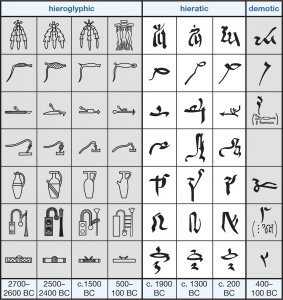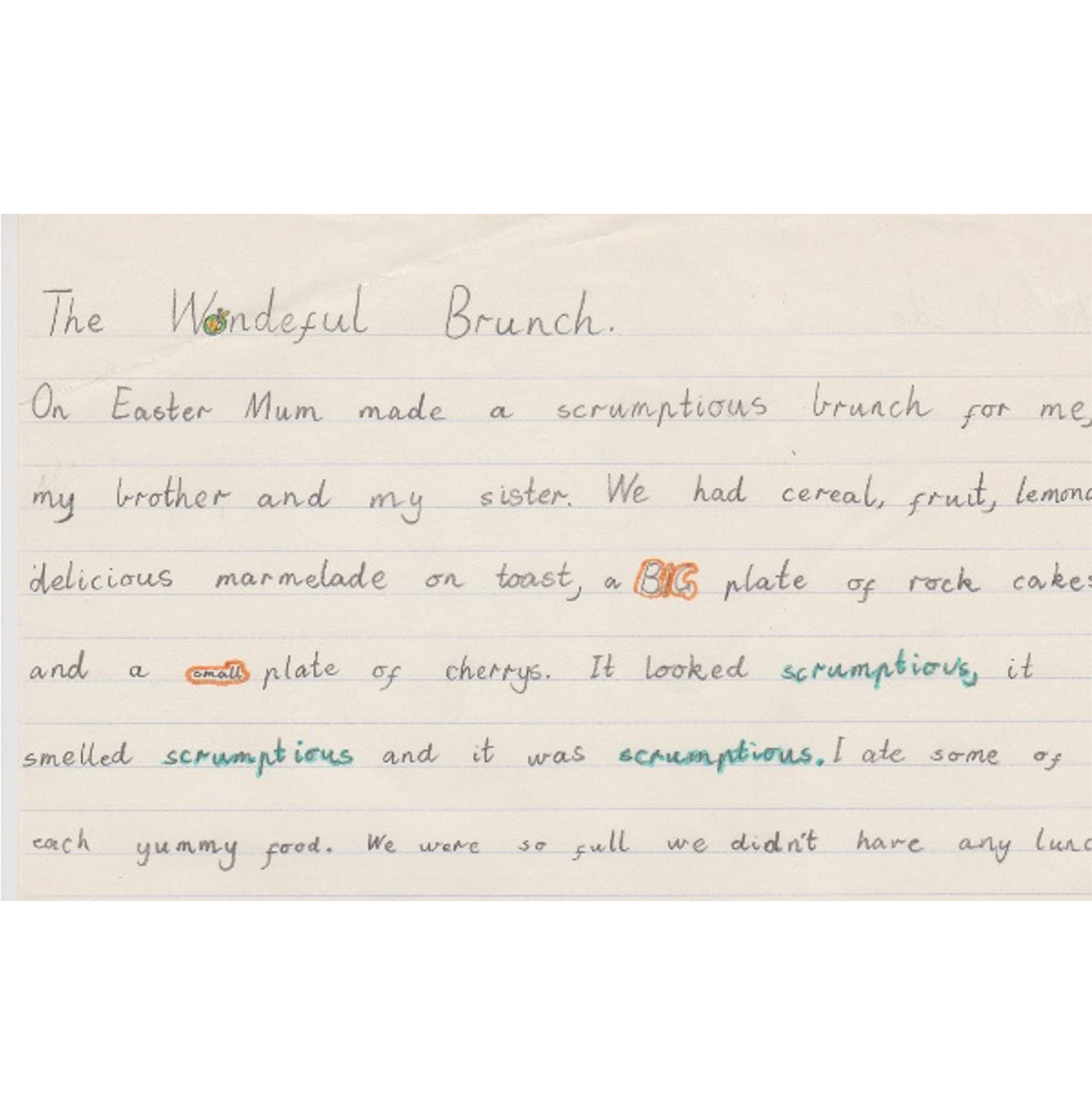Recording our thoughts and ideas, plans and hopes, onto a surface seems to be a necessary part of the human condition. We have certainly been doing it for long enough.
Reasons to write
We write for so many reasons – I have a list that I have explored and added to over the years. I regularly go through it to find a couple of reasons for a particular idea I am following, or to use with a particular group.
The list includes the following. I cut it back, but I wanted to include every idea. Every one of them is an important enough purpose for our students to write:
Figure 1 Egyptian hieroglyphs, hieratic script, and demotic script;
https://www.britannica.com/topic/hieroglyph
- To tell a story
- To unmask an injustice or cruelty
- To show a journey of change
- To describe a community or country’s way of life
- To show that life is absurd
- To describe a place
- To reveal a truth
- To leave a trace behind
- To reveal oneself
- To connect with others
- To reach out to an audience – to move them to tears, laughter, understanding, anger, hope
Lots more reasons in Why do we have to write, by Todd Finley (Edutopia April 16 2013). Here are some examples:
Because greeting cards with someone else’s sentiments are lame. • To marinate your brain in wow. • To create the next Yoda. • Write. Revise. There is no other way.
I always get caught up in the extent, the possibilities, and the potential for our students’ writing.
The tragedy – and it is a tragedy – is that our current system of data-gathering schooling largely ignores the history and the potential of writing, and instead is focused on a narrow band of measurable outcomes so much for the endless possibilities for making meaning.
Extending the audience
When we broaden the ideas our students have about writing, they can still be producing the required pieces of text and our teaching will be meeting the syllabus outcomes.
It comes back to audience and purpose.
Our students quickly learn what will keep the teacher happy, and will dutifully churn out text after text that we are satisfied with. We can introduce new vocabulary, strategies for developing imagery, connectives to aid cohesion. But without a concentrated effort by us to demonstrate the effective use of these, in authentic contexts, with authentic purposes and for a range of wider audiences, then the rest is just more stuff we ask the students to do.
When students write for an audience that is wider than the one teachers, the value of their writing is increased.
A recent piece came through from Edutopia*, titled 3 Authentic Multimodal Projects for Young Writers by Jennifer Wilkinson (Edutopia April 13, 2022).
This article describes how this teacher engaged her students deeply in their writing, because they knew they had an audience beyond the teacher. While the strategies here were used with Second Grade (Year 2), they would be easily adaptable across Stages 1-3.
- Co-construction of essential materials for the classroom – our students know what any casual or substitute teacher needs to know to work in the classroom. This strategy is authentic and its success provable.
- Go national – or global – get in touch with teachers and students in other school, in other states, and in other countries. The ideas in this section are exciting.
- Write outside the box – Wilkinson had her students create a ‘digital museum’ about how the community had changed over time, and students were then able to determine the most effective way of sharing that learning.
Writing about what we know
These three ideas are based around what the students know best – their classroom, their lives, and their community. The strategies will engage students because they are real.
The Australian Literacy Educators’ Association’s regular publication, ‘Practical Literacy: the Early and Primary Years’ include articles written by teachers in classrooms, applying effective strategies to engage and enrich student learning. It’s well worth having a look at these. It’s teachers and students working with what they know.
‘The Murrumbidgee River Project’
I once worked on a project about recognising the significance of the Murrumbidgee River to the local community. The students had their own experiences with the river, but these were limited.
So we explored the ways the river was used. This led into consideration of the history of the river’s formation, indigenous owners and the significance of the river over millennia, early white settlement, its use, crossings, floods and so on, up to the present day.
But we didn’t have enough information to write much. So we considered who currently used the river. Local people were identified, and invited to the school to talk about the importance of the river to them. The students prepared questions, and set up interview formats, and conducted formal interviews with the locals. They recorded responses, then worked on turning their notes into formal descriptions of the river and its importance to the town.
Interviewees were invited to the school for morning tea and the presentation of the completed document to the school’s library.
What had begun as a limited and vague idea became a community resource.
What writing means
We can be unsure of the best way to provide the support and guidance to allow the truths that writing can reveal to be done so as effectively as possible.
We are in the perfect position to be able to take risks with the reasons our students write.
This experiment has had the effect of increasing not only my students’ engagement but mine as well. This process has helped me to understand that the goal is … about joining my students to view writing as an adventure that we embark on together.
Jennifer Wilkinson 13/4/2022
* Edutopia is part of the George Lucas Educational Foundation:
Our Foundation is dedicated to transforming K-12 education so that all students can acquire and effectively apply the knowledge, attitudes, and skills necessary to thrive in their studies, careers, and adult lives. Founded by innovative and award-winning filmmaker George Lucas in 1991, we take a strategic approach to improving K-12 education through two distinct areas of focus: Edutopia and Lucas Education Research.
There is an introductory video you can access at Celebrating What Works in Education – YouTube









